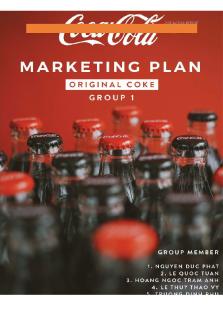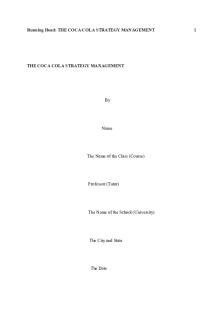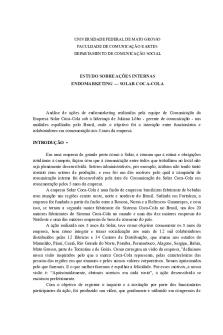Introduction coca PDF

| Title | Introduction coca |
|---|---|
| Course | Management |
| Institution | Nahda University |
| Pages | 13 |
| File Size | 212 KB |
| File Type | |
| Total Downloads | 34 |
| Total Views | 135 |
Summary
assignment...
Description
Introduction The beverage industry of Bangladesh is an old, steady yet neglected industry. For many years, the only product of the industry was Carbonated Beverage or Carbonated Soft Drink (CSD) and the number of players was limited to only a handful. Today, the industry has flourished considerably with a bunch of new enterprises and through the introduction of newer and more diverse products.
Objective of the study The major purpose of this report is to focus light on one of the oldest and key player of the beverage industry of Bangladesh, Abdul Monem Ltd. (abbreviated as AML). The underlying objectives of the report are : • To know about the inception of the enterprise, as a whole and of its beverage unit as well. • To know the operations and the management structure of AML. • Put light on the production, distribution and promotion of the beverage products of AML. • To review the strategic moves and plans of AML as a Strategic Business Unit to gain market share, make good profit and achieve sustainable growth. • Recommend relevant strategic moves to achieve even better result. • Conduct a sample survey and interpret the results to visualize whether the strategies of AML are working well for the enterprise.
SWOT Analysis of Coca-Cola (Market Leader): SWOT stands for Strengths, Weakness, Opportunities & Threats. SWOT analysis is a technique much used in many general management as well as marketing scenarios. SWOT consists of examining the current activities of the organization- its Strengths and Weaknesses & then using this and external research data to set out the Opportunities and Threats that exist.
A chart of SWOT Analysis of Coca-Cola in Bangladesh:
Strengths:
Weaknesses:
1. Strong brand name
1.Similar taste like Pepsi
2. World’s largest market share in beverage
2. Containing extra sugar
3. Strong marketing and advertising
3. Over dependency on the international CocaCola authority
4. Most extensive beverage distribution channel 4. Significant focus on carbonated drinks 5. Customer loyalty
Opportunities:
Threats:
1. Introduction of new products
1. Strong competition
2. Growth through acquisitions
2. Potential health issues
3. Increasing demand for healthy food and
3. Dominance of substitute beverage products
beverage
like fruit juice
4. Increasing beverages consumption during
4. Water scarcity
summer season
Description of the above chart : Strengths: 1. Strong brand name: Coca-Cola has a strong brand name all over the world. So, it is counted as the most powerful strength of Coca-Cola in Bangladesh. Beside this, they also have a great position in the international market. According to Interbrand, The Coca-Cola Company is the most valued ($77,839 billion) brand in the world. 2. World’s largest market share in beverage: Coca-Cola is the world’s first commerciallybased beverage company. It holds the largest beverage market share in the world (about 40%). 3. Strong marketing and advertising: Coca-Cola provides strong marketing & advertising all over Bangladesh through their selective distributors. 4. Most extensive beverage distribution channel: Coca-cola serves more than 200 countries and more than 1.7 billion servings a day. 5. Customer loyalty: The customers of Coca-Cola in Bangladesh are very loyal due to their strong satisfaction towards it.
Weaknesses: 1. Similar taste like Pepsi: Coca-Cola’s taste is almost similar as Pepsi. It is the biggest weakness of Coca-Cola in Bangladesh.
2. Containing extra sugar: Coca-Cola contains extra sugar which is harmful for its consumers. 3. Over dependency on the international Coca- Cola authority: In Bangladesh, the local distributors are completely dependent on the international Coca- Cola authority. For this reason, the local competitors get some extra benefits. 4. Significant focus on carbonated drinks: Coca-Cola strongly focuses on carbonated drinks whereas local competitors focus on other sectors of soft drinks also.
Opportunities: 1. Introduction of new products: Coca-Cola can introduce other world famous brands of it like Bislery (Drinking Water), Maaza (Mango Drink) and others in Bangladesh. 2. Growth through acquisitions: Coca-Cola will find it hard to keep current growth levels and will find it hard to penetrate new markets with its existing product portfolio. This problem can be solved more easily through acquiring other companies in Bangladesh. 3. Increasing demand for healthy food and beverage: Due to many programs to fight obesity, demand for healthy food and beverages has increased drastically. The Coca Cola Company has an opportunity to further expand its product range with drinks that have low amount of sugar and calories. 4. Increasing beverages consumption during summer season: During the summer season in Bangladesh, people consume more soft drinks than other seasons to meet up their thirst. Like as local competitors, Coca-Cola can take many promotional activities during this season of the year.
Threats: 1. Strong competition: Strong competition is one of the biggest threats for Coca-Cola in Bangladesh.
2. Potential health issues: Potential health issues can also be a threat for Coca-Cola due to its extra sugar & calories. 3. Dominance of substitute beverage products like fruit juice: Dominance of substitute beverage products like fruit juice is a new threat for Coca-Cola as other local soft drink brands of Bangladesh introduce many fruit juices day by day. For example- Frutika, Mangoole etc. 4. Water scarcity: Water scarcity can be a great problem for Coca-Cola due to the heavy wastages of water in Bangladesh by local industrial plants.
Porter’s Five Forces Model of Coca Cola There are various forces, which define the attractiveness of the market for operating companies. In this framework, a business environment can be either attractive or unattractive. Attractiveness occurs when there is maximum profitability. On the other hand, pure competition in the market leads to it being unattractive, as players in the market make almost zero profit because of market constrain. Porter’s five forces model is important in understanding these forces. This essay discusses this model, with reference to Coca-Cola, leading beverage manufacturer, worldwide.
Competitive Rivalry within an Industry Beverage industry competition can be classified as a Duopoly with Pepsi and Coca Cola. The market share of other competitors is too low to encourage any price wars. Cola-Cola gets competitive advantage through the well-known global trade marks by achieving the premium prices. It means Cola-Cola have something that their competitors do not have. While Pepsi has leveraged its worldwide brand-building strength to attach with consumers in significant ways and impel the growth globally. The number and relative size of the competitors:
If there are many organizations of a similar size, as in monopolistic competition then rivalry will be intense. Organizations in the industry are likely to try to gain market share through all possible means. In industries with relatively few organizations, or where one or two organizations dominate, rivalry tends to be much less and the market much more stable. The rate of growth in an industry: Market growth in industries where product innovation and displacement are dominant is likely to be very different from that of the more traditional sectors. Cost conditions: If organizations operate in a business with relatively high fixed costs it will be in the interests of that organization to cut its prices in order to sell its output.
High exit barriers: Exit barriers can be measured by the costs organizations incur when they leave an industry. Exit barriers are said to be high if the cost of leaving in an industry is high. These costs can include redundancy payments and the low scrap value of the plant.
Threat of Competitors’ Entry Soft drink industry is expensive, as it requires massive investing in advertising and marketing. Because of the billions that current players pump in the market, new entrants have a hard time to breakthrough. Coca Cola and Pepsi further enjoy high customer loyalty, because of their high brand equity. Thus, new competitors find it almost impossible to counterpart this loyalty. The industry further has important margins to retailers, ranging between 15 and 30%, which allow retailers to be comfortable with current players. New entrants also fear retaliation as Coca Cola and Pepsi will not allow them to enter. Legal barriers: Legal barriers such as govt. license, charter or a patent, may also be used. A license is required in many fields of business including the taxi cab, banking and broadcasting sectors. Capital requirements:
The need for capital is linked closely to the sunk costs. It may be too expensive for an organization to enter a market. One attempt at entry ended with the incumbents starting a price war forcing its new rival out.
Threat of Substitute Products The beverage industry is replete with substitutes. In other words, consumers have the option of buying other products. Common substitutes include water, tea, coffee, juices and beer among others. However, suppliers of these products need top-notch brand equity, brand loyalty, advertising muscles, so that their products reach target customers with a lot of ease. However, most of the companies offering substitutes cannot match the pace set by Coca Cola and Pepsi as market leaders.
The propensity of the buyer to substitute: A critical factor is the propensity, tendency of a buyer to substitute. If the propensity of a buyer to substitute is high then substitutes will present a great threat. Some products have low propensity of substitution because of the brand loyalty that has been established. Switching costs: The one-off cost that faces a buyer when switching from one supplier to another is important. Where the switching cost is high then transfer to allegiances is less likely and vice-versa.
Chart of SWOT Analysis as anew firm in Bangladesh:
A Strength
Weakness
Attractive brand name
Lack of capital
Reasonable pricing
Lack of proper management
Attractive packaging
Low reputation
Good relationships with
No market share
suppliers
Opportunity
Location factors
Threat
Dominance of the existing competitors
Making campaign
Different taste of flavor
Acquiring the new technology
Change in consumer preferences
Legal requirements to disclose negative information on product labels
Strength :
Findings from the survey • Abdul Monem Ltd. is still the market leader for the glass bottled beverage market in Bangladesh, mainly due to the fact that most of the rivals do not produce glass bottled beverages. • Its market share in PET bottled and Canned beverage market has seriously declined and on a serious threat under the aggression of the rivals in this segment. • However, the establishment and infrastructure of Abdul Monem Ltd. to distribute the product to the footstep of the consumer remained best of all
Key Findings • The carbonated beverage industry of Bangladesh is visibly a matured and declining industry. • The existing market of carbonated beverage is seriously threatened by the emergence of other substitute beverage products. • Due to the narrow product line, AML and its beverage unit is having a hard time to maintain its share in the market. • Over the last decade, numerous number of new enterprises has entered the industry and eventually have swamped the industry for its volume. • The policy and technology determined by the Coca Cola Company, USA are not always suitable for the case of Bangladesh.
CONCLUSION
It was observed that Coca-Cola has been perceived quite positively as it has been projected. People are aware of the Brand & Awareness of Coca-Cola is quite high in the market. When a product is launched, avid Coke drinkers choose this soda over any other competitor simply because it's a Coca-Cola product and they trust it.
Although Coke has been into controversies, people still prefer to stay loyal to the Brand with Coca-Cola being termed as a more popular brand than Pepsi.
Coca-Cola products would appear, on the shelf, to have the most expensive range of soft drinks common to supermarkets, at almost double the cost of no name brands. This can be for several reasons apart from just to cover the extra costs of promotions, for which no name brands do without. When people buy Coca-Cola they are not just
buying the beverage but also the image that goes with it, therefore to have the price higher reiterates the fact that the product is of a better quality than the rest and that the consumer is not cheap.
Recommendations
• To introduce other well anticipated products of Coca Cola Company in local market. • Going for some alliance with some of the major rivals or if possible acquiring some of them. • As the oldest enterprise in the beverage industry of the country, the only cost AML can consider is the variable cost of the product and can forget about the establishment cost as it should have been recovered after all these days. Thus, AML can consider a serious price cut to rule out the smaller player from the market and gain more share.
References
Porter’s Five Forces Model, retrieved 9 April, 2017 from http://mbalectures.com/marketing/principles-of-marketing/1119/porters-five-forces-model-ofcoca-cola.html
An Example Five Forces Analysis of Coca-Cola, retrieved 9 April, 2017 from http://reportstation.com/example-five-forces-analysis-coca-cola/
The Cola war: Coke’s Porter’s Five Force Model, retrieved 9 April, 2017 from http://www.brighthub.com/office/entrepreneurs/articles/79263.aspx
Coca-Cola Porter’s Five Forces Analysis, retrieved 11 April, 2017 from http://research-methodology.net/coca-cola-porters-five-forces-analysis/
Ian Brooks and Jamie Weatherston, The Business Environment: The Competitive Environment (Chapter 2)
SWOT: Coca-Cola, retrieved 15 April, 2017 from https://www.academia.edu/16591062/SWOT_on_Coca-Cola_Company...
Similar Free PDFs

Introduction coca
- 13 Pages

Coca cola
- 7 Pages

Coca Cola-SWOT - Coca Cola-SWOT
- 4 Pages

PROCESO ADMINISTRATIVO COCA COLA
- 1 Pages

COCA-COLA CASE STUDY
- 13 Pages

Coca Cola Strategy Management
- 9 Pages

Endomarketing - Solar Coca-Cola
- 5 Pages

Coca cola case study
- 2 Pages

Coca Cola Sustainability
- 11 Pages

Synthèse exposé coca-cola
- 2 Pages

Coca-cola - final summary
- 2 Pages

COCA COLA assignment official
- 15 Pages

Coca Cola Marketing Plan
- 11 Pages
Popular Institutions
- Tinajero National High School - Annex
- Politeknik Caltex Riau
- Yokohama City University
- SGT University
- University of Al-Qadisiyah
- Divine Word College of Vigan
- Techniek College Rotterdam
- Universidade de Santiago
- Universiti Teknologi MARA Cawangan Johor Kampus Pasir Gudang
- Poltekkes Kemenkes Yogyakarta
- Baguio City National High School
- Colegio san marcos
- preparatoria uno
- Centro de Bachillerato Tecnológico Industrial y de Servicios No. 107
- Dalian Maritime University
- Quang Trung Secondary School
- Colegio Tecnológico en Informática
- Corporación Regional de Educación Superior
- Grupo CEDVA
- Dar Al Uloom University
- Centro de Estudios Preuniversitarios de la Universidad Nacional de Ingeniería
- 上智大学
- Aakash International School, Nuna Majara
- San Felipe Neri Catholic School
- Kang Chiao International School - New Taipei City
- Misamis Occidental National High School
- Institución Educativa Escuela Normal Juan Ladrilleros
- Kolehiyo ng Pantukan
- Batanes State College
- Instituto Continental
- Sekolah Menengah Kejuruan Kesehatan Kaltara (Tarakan)
- Colegio de La Inmaculada Concepcion - Cebu


